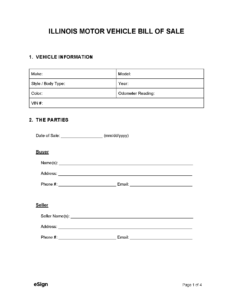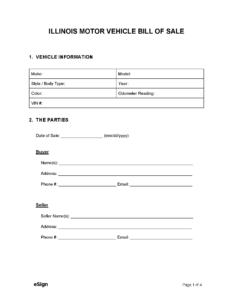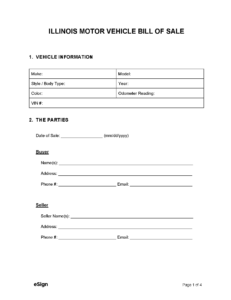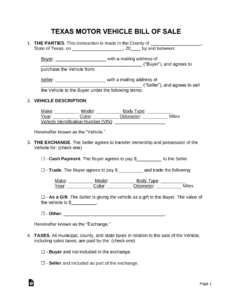Navigating the sale or purchase of a vehicle can feel like a maze, with various forms and legalities to consider. One document that often gets overlooked, but is absolutely essential, is a car bill of sale. While Illinois doesn’t strictly require a bill of sale for vehicle registration, having one is a smart move for both buyers and sellers, providing a clear record of the transaction and protecting both parties from potential disputes down the line. It serves as your official proof of ownership transfer, documenting the agreement made between the buyer and seller.
Think of it as a crucial receipt for your car. It’s not just a piece of paper; it’s a legally binding document that outlines the details of the sale, from the vehicle’s specifics to the agreed-upon price and the date the transfer occurred. Whether you’re selling your trusty sedan or finally getting that new-to-you SUV, understanding the ins and outs of this document, and knowing where to find a reliable car bill of sale Illinois template, will make your transaction much smoother and more secure.
Why a Bill of Sale is Crucial for Your Illinois Car Sale
Even though the state of Illinois doesn’t mandate a bill of sale for registering a vehicle, failing to use one can leave you vulnerable to a host of problems. For sellers, it’s your definitive proof that you no longer own the vehicle, which is vital for liability purposes. Imagine if the car you sold was involved in an accident or received parking tickets after you handed over the keys. Without a clear bill of sale, you could potentially be held responsible, as state records might still show you as the owner. This document officially transfers the liability from your name to the buyer’s.
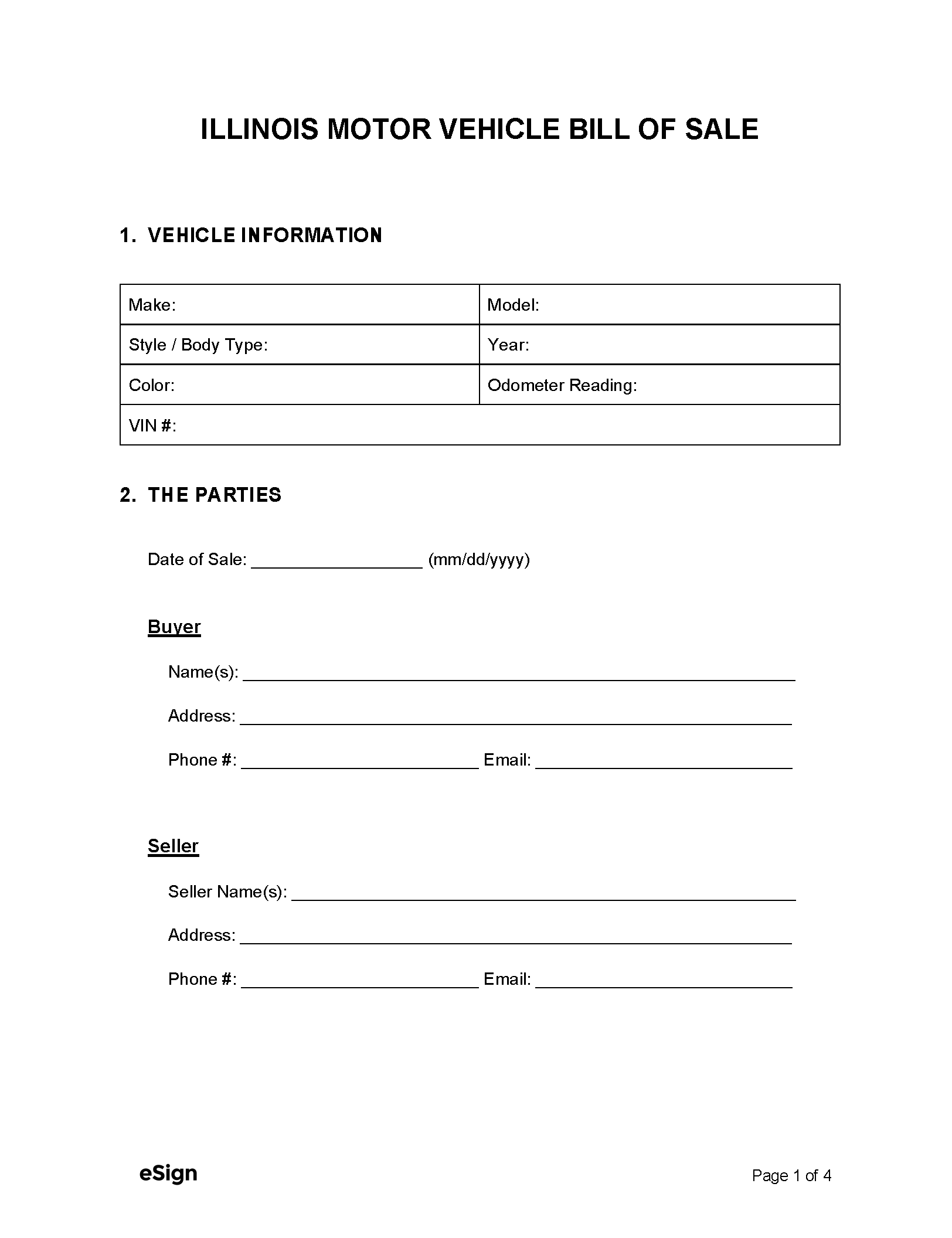
For buyers, a bill of sale acts as your initial proof of purchase. While you’ll eventually receive a title, the bill of sale confirms the transaction occurred, states the price you paid, and outlines any conditions of the sale. This is especially important if there’s a delay in receiving the title or if any discrepancies arise regarding the vehicle’s condition as described by the seller. It solidifies the terms agreed upon and provides a paper trail for your records, protecting your investment.
Furthermore, a detailed bill of sale can prevent misunderstandings about the vehicle’s condition “as is” or if any warranties are implied or explicitly excluded. It’s the perfect place to document any specific agreements, such as whether accessories are included or excluded from the sale. A well-prepared car bill of sale Illinois template ensures that all critical information is captured, leaving no room for ambiguity.
Key Information to Include
- Buyer’s and Seller’s Information: Full legal names, addresses, and contact details for both parties.
- Vehicle Details: Make, model, year, vehicle identification number (VIN), odometer reading (clearly stating if it’s actual mileage or not), and current license plate number.
- Sale Price and Payment Method: The exact agreed-upon purchase price and how the payment was made (e.g., cash, check, cashier’s check).
- Date of Sale: The specific date the transaction took place.
- “As Is” Clause: A statement indicating the vehicle is sold “as is” without any warranties, unless otherwise specified.
- Signatures: Signatures of both the buyer and seller, acknowledging their agreement to the terms.
Having all these details clearly laid out in your bill of sale provides a comprehensive record that can be invaluable should any questions or disputes arise in the future. It’s truly a cornerstone for a smooth and secure private vehicle sale in Illinois.
How to Safely Complete Your Illinois Car Bill of Sale
Once you understand the importance of this document, the next step is knowing how to properly complete it. Fortunately, finding a car bill of sale Illinois template is quite straightforward. Many legal document websites, automotive resources, and even some government sites offer free, printable versions that you can fill out. Always opt for a reputable source to ensure the template includes all necessary legal components and is up-to-date with general Illinois sale practices, even if not state-mandated.
When filling out the template, accuracy is paramount. Double-check all spellings, numbers, and dates. Ensure the VIN is transcribed exactly as it appears on the vehicle and the title. Any discrepancy could lead to issues later when the buyer attempts to register the vehicle or if a legal challenge arises. It’s a good practice for both the buyer and seller to be present during the completion of the document to verify all information together.
It’s highly recommended to prepare at least two copies of the completed and signed bill of sale. Each party should retain an original signed copy for their records. Some even suggest a third copy, especially if you plan to submit a copy to your insurance company or for tax purposes, though this isn’t always required in Illinois. This ensures that both the buyer and seller have a complete and identical record of the transaction.
Here are a few practical tips to ensure a safe and effective completion:
- Meet in a Safe Location: Consider a public place for the transaction.
- Verify Identities: Ask to see a valid driver’s license or state ID from the other party. You might even record the ID number on the bill of sale if both parties agree.
- Inspect the Vehicle (Buyer): Before signing, the buyer should thoroughly inspect the car or have it inspected by a trusted mechanic.
- Review Payment (Seller): Verify the payment method and ensure funds have cleared before handing over the keys and title.
- Notarization (Optional but Recommended): While not required in Illinois for a bill of sale, getting it notarized adds an extra layer of legal validity by verifying the identities of the signers.
By following these steps, you can ensure that the car bill of sale serves its purpose effectively, providing legal clarity and peace of mind for both the buyer and seller involved in the transaction.
Successfully navigating the private sale of a vehicle, whether you’re the buyer or the seller, hinges on meticulous attention to detail and a clear understanding of the necessary documentation. By taking the time to properly fill out and understand a bill of sale, you’re not just completing a form; you’re creating a robust shield against future complications. This straightforward step dramatically simplifies the process and secures your position in the transaction.
Having this formal record in hand offers invaluable peace of mind, allowing both parties to move forward confidently. It’s the final handshake, legally documented, ensuring a smooth transition of ownership and protecting the interests of everyone involved long after the keys have changed hands.
